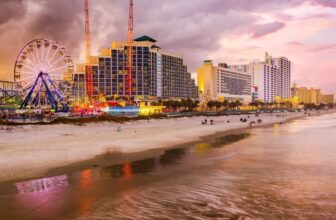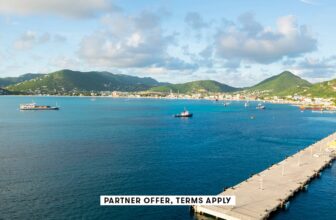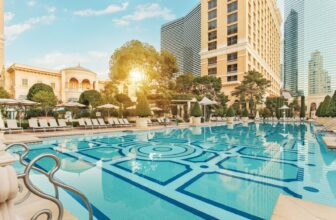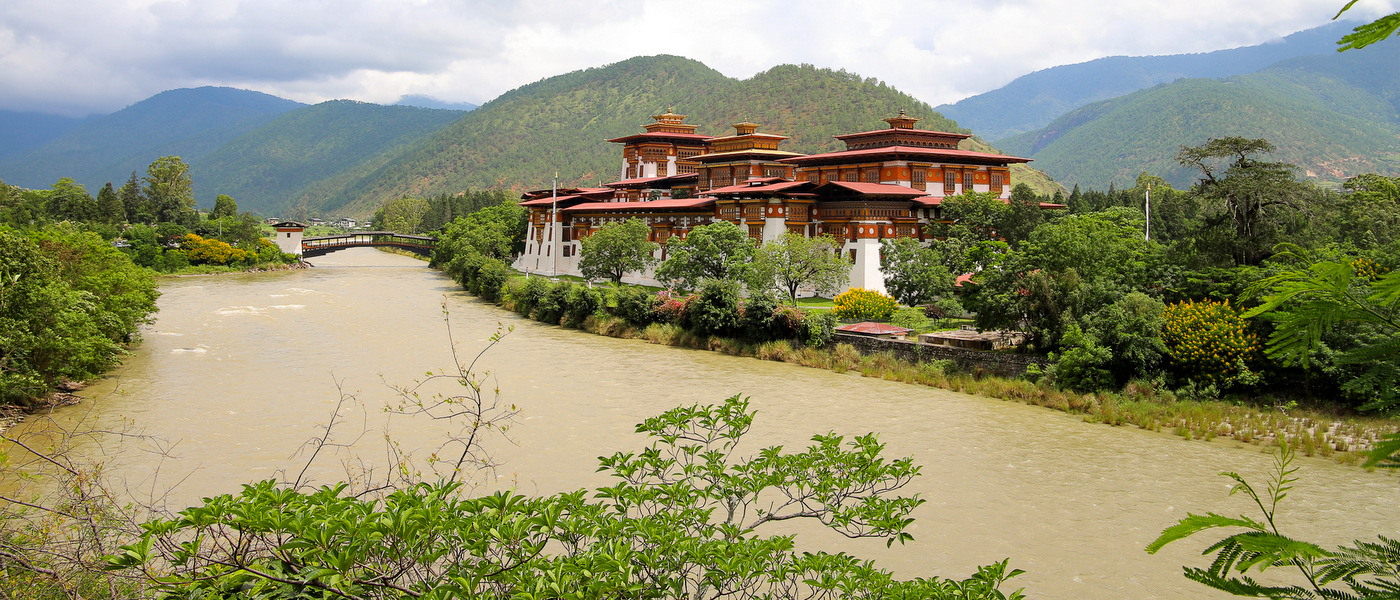
[ad_1]
A Himalayan Kingdom that has only been open to the outside world since 1974, and a country that measures success by Gross National Happiness, Bhutan has always fascinated us. Adding to the intrigue of “The Land of the Thunder Dragon,” they took pandemic precautions to a new level and closed their borders for the last 2.5 years. The country finally opened to visitors on September 23rd, 2022…but through a series of governmental hoops and a stroke of magic, we were invited in early to help show that Bhutan is back and better than ever. During the 916 days without visitors, the kingdom took that quiet time to polish every facet of its tourism sector, including countrywide hotel renovations, transportation improvements, and personnel training. They also furthered their commitment of being a carbon-negative country with a slew of new sustainability initiatives—from an electric taxi fleet to the Million Tree Project. It was an incredible honor to be among the first travelers to experience the “New Bhutan” and cover the story for Travel & Leisure, and now (in juicier detail) for our HoneyTrek fans. From trekking to the famous Tiger’s Nest to flying in the cockpit over Mount Everest, joining a mask dance festival, glamping at 12,000 feet, river rafting past 17th-century fortresses, sleeping in Buddhist temples, planting trees, to sharing tea with nomadic cow herders, we’ve got a lot to share in our new Bhutan travel guide.
Flying in the Cockpit with Drukair
 Traveling from the US to Qatar to India to Bhutan, we were tempted to pass out on the last leg, but we weren’t about to sleep through this legendary flight over the Himalayas—or miss out on Drukair’s first-class service. Our flight attendants in formal Bhutanese dress, delivered champagne and chilled towels, and said “When you’re finished, the captain would like you to join him in the cockpit for takeoff.” Say wha? This would be extraordinary on any post-9/11 flight, but the trip to Paro, Bhutan also happens to be one of the world’s most technical routes. Making the descent between the 18,000-foot peaks, down a narrow valley and a very short runway,can only be done during the day, manually, and by less than two dozen pilots in the world, but we didn’t let that worry us. Captain Kinga Tshering and First Officer Tashi Tshering welcomed us with smiles and full-body seat belt instructions. Once we hit cruising altitude the captain showed us a list of the 10 tallest mountains in the world, he said, “We’ll pass by five of them, including Everest.” Then piercing through the clouds, we saw the peaks normally reserved for the world’s greatest climbers. I almost wept. We returned to our seats for a lovely lunch of veggie stir fry, accompanied by Bhutan’s signature red rice beer. As the flight attendant cleared our plates, she offered us a variety of international newspapers to read or the choice to return to the cockpit for landing. We nearly leapt out of our seat and joined the pilots for the descent with lush green mountains at eye level and an airport that looked more like a gilded palace. We landed in without a bump and had an overwhelming feeling…this is gonna be a trip like no other. Watch our TikTok video, where we got to do the same cockpit flight in reverse.
Traveling from the US to Qatar to India to Bhutan, we were tempted to pass out on the last leg, but we weren’t about to sleep through this legendary flight over the Himalayas—or miss out on Drukair’s first-class service. Our flight attendants in formal Bhutanese dress, delivered champagne and chilled towels, and said “When you’re finished, the captain would like you to join him in the cockpit for takeoff.” Say wha? This would be extraordinary on any post-9/11 flight, but the trip to Paro, Bhutan also happens to be one of the world’s most technical routes. Making the descent between the 18,000-foot peaks, down a narrow valley and a very short runway,can only be done during the day, manually, and by less than two dozen pilots in the world, but we didn’t let that worry us. Captain Kinga Tshering and First Officer Tashi Tshering welcomed us with smiles and full-body seat belt instructions. Once we hit cruising altitude the captain showed us a list of the 10 tallest mountains in the world, he said, “We’ll pass by five of them, including Everest.” Then piercing through the clouds, we saw the peaks normally reserved for the world’s greatest climbers. I almost wept. We returned to our seats for a lovely lunch of veggie stir fry, accompanied by Bhutan’s signature red rice beer. As the flight attendant cleared our plates, she offered us a variety of international newspapers to read or the choice to return to the cockpit for landing. We nearly leapt out of our seat and joined the pilots for the descent with lush green mountains at eye level and an airport that looked more like a gilded palace. We landed in without a bump and had an overwhelming feeling…this is gonna be a trip like no other. Watch our TikTok video, where we got to do the same cockpit flight in reverse.
Our Bridge to Bhutan Family
 We exited the Paro airport and our Bridge to Bhutan guides, met us with traditional white silk scarves and our chariot for the next 18 days together. We don’t normally do multi-day tours, but Bhutan is unique in that certified guides are required to travel outside the two major cities, plus we really connected with Bridge to Bhutan as a travel company. Founded by two Bhutanese brothers, Fin & Lotay, who studied International Sustainable Development and Environmental Studies, and come from a family that has worked in both tourism and the government, they are deeply committed to the future of sustainable travel in Bhutan. We’d been chatting with Lotay on Instagram since 2019, so by the time we arrived in Bhutan it was like visiting old friends. We reached the Pamtsho Hotel, and Fin, Auntie Uygen, Uncle Tsewang, and multiple cousins, ushered us in for a vegan feast in their new restaurant. We were their first hotel guests since 2020. Over bottomless bowls of pumpkin soup, garlic roasted vegetables, ginger-fried rice, Sichuan pepper tofu, and lots of chilies, we chatted out our upcoming journey. Not just pulling from a stock itinerary, the team was looking at the latest road conditions, weather, cultural happenings, and familial ceremonies to craft the most dynamic trip for our travel style.
We exited the Paro airport and our Bridge to Bhutan guides, met us with traditional white silk scarves and our chariot for the next 18 days together. We don’t normally do multi-day tours, but Bhutan is unique in that certified guides are required to travel outside the two major cities, plus we really connected with Bridge to Bhutan as a travel company. Founded by two Bhutanese brothers, Fin & Lotay, who studied International Sustainable Development and Environmental Studies, and come from a family that has worked in both tourism and the government, they are deeply committed to the future of sustainable travel in Bhutan. We’d been chatting with Lotay on Instagram since 2019, so by the time we arrived in Bhutan it was like visiting old friends. We reached the Pamtsho Hotel, and Fin, Auntie Uygen, Uncle Tsewang, and multiple cousins, ushered us in for a vegan feast in their new restaurant. We were their first hotel guests since 2020. Over bottomless bowls of pumpkin soup, garlic roasted vegetables, ginger-fried rice, Sichuan pepper tofu, and lots of chilies, we chatted out our upcoming journey. Not just pulling from a stock itinerary, the team was looking at the latest road conditions, weather, cultural happenings, and familial ceremonies to craft the most dynamic trip for our travel style.
Thimphu: Bhutan’s Capital
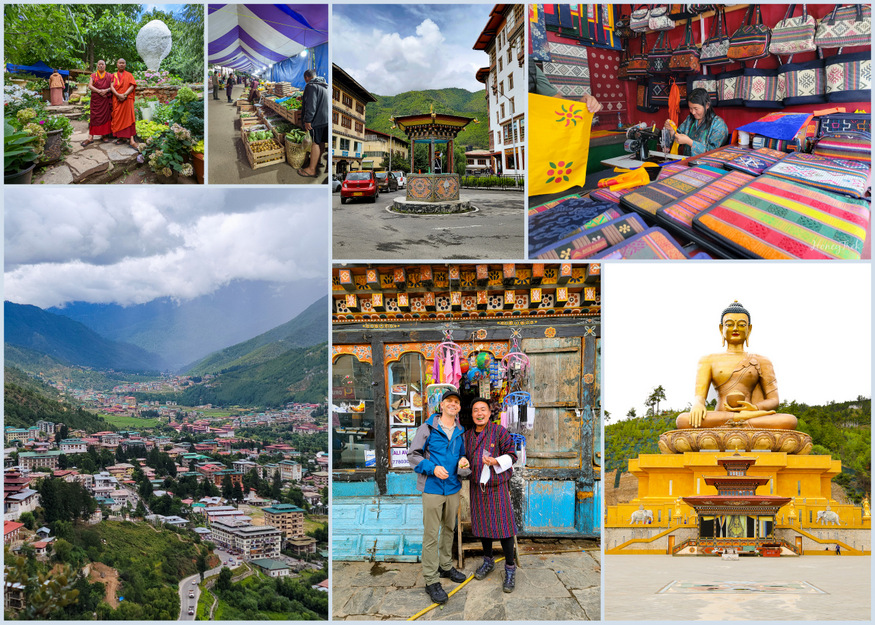 The “big” city of Thimphu is set in a gorgeous valley, anchored by their 13th-century dzong (a fortified monastery) and a small downtown of ~115,000 people. While the capital is rapidly expanding, it still doesn’t have a single stoplight and certainly hasn’t lost its sense of tradition. New buildings are constructed with Bhutan’s traditional woodworking and adorned with colorful Buddhist motifs. Walking around downtown most citizens wear the national dress, a robe-like “gho” for men and long “kira” skirts for women, looking impeccable whether they are running a bank or a fruit stall. We loved our time wandering the hilly streets, nibbling our way through the momo dumpling stalls, watching artisans at the Thimphu Handicraft Market, catching an archery tournament at the Changlimithang Stadium, and sampling foods at the new riverside farmer’s market. For the best views of the city, we headed up to Kuensel Phodrang Hill to see The Great Buddha Dordenma (one of the largest sitting Buddhas in the world) and to get a feel for the topography of Bhutan, a nation built into the slopes of the Himalayas and gathered together in its valleys. For the best places to go in the capital city, see our Thimphu Facebook gallery.
The “big” city of Thimphu is set in a gorgeous valley, anchored by their 13th-century dzong (a fortified monastery) and a small downtown of ~115,000 people. While the capital is rapidly expanding, it still doesn’t have a single stoplight and certainly hasn’t lost its sense of tradition. New buildings are constructed with Bhutan’s traditional woodworking and adorned with colorful Buddhist motifs. Walking around downtown most citizens wear the national dress, a robe-like “gho” for men and long “kira” skirts for women, looking impeccable whether they are running a bank or a fruit stall. We loved our time wandering the hilly streets, nibbling our way through the momo dumpling stalls, watching artisans at the Thimphu Handicraft Market, catching an archery tournament at the Changlimithang Stadium, and sampling foods at the new riverside farmer’s market. For the best views of the city, we headed up to Kuensel Phodrang Hill to see The Great Buddha Dordenma (one of the largest sitting Buddhas in the world) and to get a feel for the topography of Bhutan, a nation built into the slopes of the Himalayas and gathered together in its valleys. For the best places to go in the capital city, see our Thimphu Facebook gallery.
Bhutan Postal Museum
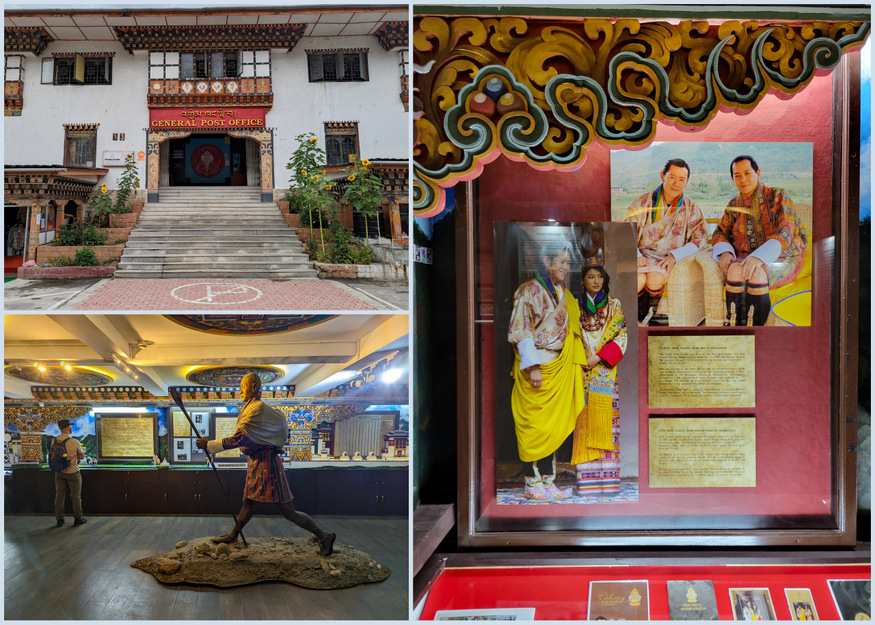 This might sound obscure, but if there is one museum you need to visit in Thimphu, it’s the Postal Museum. In addition to Bhutan’s fascinating history of communication, from the mountain mail runners (the only delivery option until the 1960s) to the arrival of the payphone in the 1990s, it’s also a great overview of how Bhutan transitioned into the modern world. Largely starting with King Jigme Dorji Wangchuck (the third of five kings to date) who brought roads, a public transportation system, and international mail service to the country by 1968. The fourth king, saw his country opening up and sought a way to continue modernizing while still honoring tradition. He came up with the concept of Gross National Happiness as their measurement of success and guiding force in the face of globalization. With a strong sense of national identity, he passed the crown to the present king, His Majesty King Jigme Khesar Namgyel Wangchuck, to usher in a more progressive era with a democratic constitutional monarchy (meaning that the king is head of state, executive power is vested in the cabinet, and citizens can vote). Now that king’s role is less mired in governmental duties, the royal family is focused on doing everything they can to make their people happy and everyone loves them for it! Plus, the Bhutan Postal Museum holds a stamp collection like no other…scented, singing, 3D, selfie stamps, and other uniquely Bhutanese postage.
This might sound obscure, but if there is one museum you need to visit in Thimphu, it’s the Postal Museum. In addition to Bhutan’s fascinating history of communication, from the mountain mail runners (the only delivery option until the 1960s) to the arrival of the payphone in the 1990s, it’s also a great overview of how Bhutan transitioned into the modern world. Largely starting with King Jigme Dorji Wangchuck (the third of five kings to date) who brought roads, a public transportation system, and international mail service to the country by 1968. The fourth king, saw his country opening up and sought a way to continue modernizing while still honoring tradition. He came up with the concept of Gross National Happiness as their measurement of success and guiding force in the face of globalization. With a strong sense of national identity, he passed the crown to the present king, His Majesty King Jigme Khesar Namgyel Wangchuck, to usher in a more progressive era with a democratic constitutional monarchy (meaning that the king is head of state, executive power is vested in the cabinet, and citizens can vote). Now that king’s role is less mired in governmental duties, the royal family is focused on doing everything they can to make their people happy and everyone loves them for it! Plus, the Bhutan Postal Museum holds a stamp collection like no other…scented, singing, 3D, selfie stamps, and other uniquely Bhutanese postage.
Haa Valley Homestay
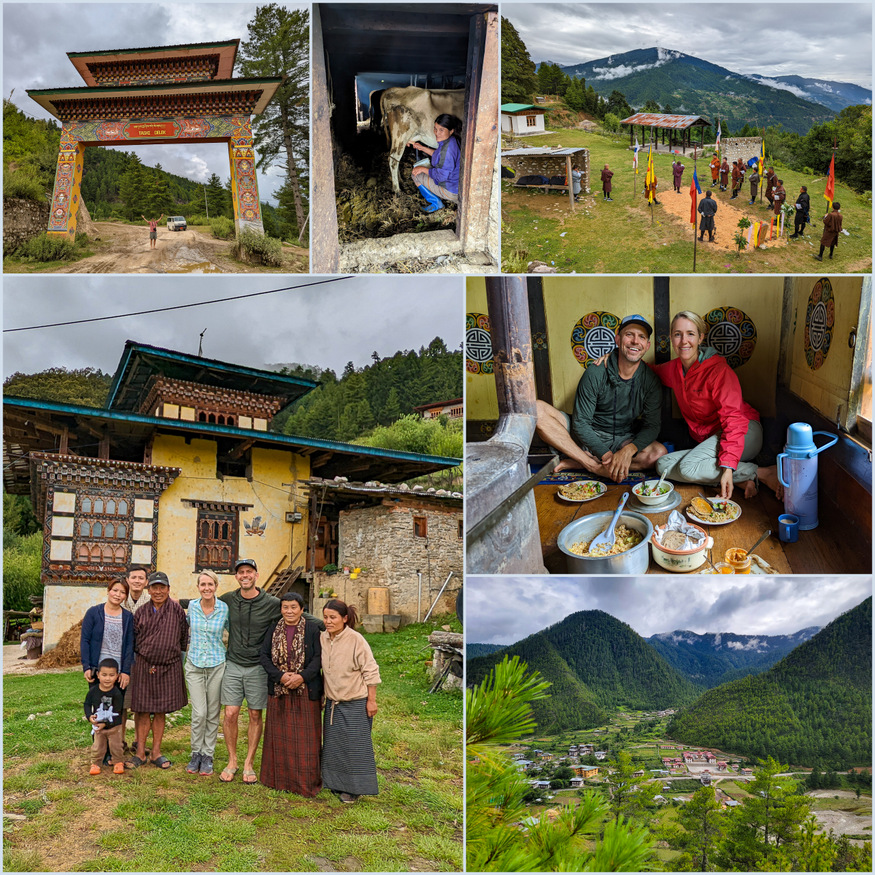 When Fin received an invite for an annual house blessing ceremony in his family’s ancestral village, we bee-lined to Haa Valley. This western district was a restricted area until 2003 and many of the mountain villages are only now getting roads…including their village of Dorikha. Fin and Lotay’s mother grew up here in a nomadic cow herding family, moving between their summer and wintering grounds on foot and sheltering in stone huts in between. She now lives in Thimphu, but often returns to be with the herd and reconnect with mountain life, like she did this week. Driving the unpaved switchback roads to 10,000 feet, we reached Dorikha and the family farmhouse. We spent two nights sharing meals around the wood-burning stove, shadowing the morning chores of milking cows and making cheese, and spending time in the 20-house village, which centers around a beautiful temple and archery range (both of equal cultural importance).
When Fin received an invite for an annual house blessing ceremony in his family’s ancestral village, we bee-lined to Haa Valley. This western district was a restricted area until 2003 and many of the mountain villages are only now getting roads…including their village of Dorikha. Fin and Lotay’s mother grew up here in a nomadic cow herding family, moving between their summer and wintering grounds on foot and sheltering in stone huts in between. She now lives in Thimphu, but often returns to be with the herd and reconnect with mountain life, like she did this week. Driving the unpaved switchback roads to 10,000 feet, we reached Dorikha and the family farmhouse. We spent two nights sharing meals around the wood-burning stove, shadowing the morning chores of milking cows and making cheese, and spending time in the 20-house village, which centers around a beautiful temple and archery range (both of equal cultural importance).
Hiking Tergo-la & The Dying Art of Nomadic Herding
 Just a short drive away and along the trail to their family’s herding camp is a hike that has been rated among the best in the world by CNN. From the 12,000-foot Tergo-La Pass, we climbed the craggy mountain, chiseled by creeks and covered in wildflowers, and got views to India and Tibet. After a few hours, we reached a clearing with two stone huts and smiling faces ushering us in for tea and Parle-G cookies. We sat cross legged on a bed of pine needles and were served countless refills, as we chatted and pet the cows. The 20-year-old daughter, Pema, spoke English perfectly and told us she was just visiting from university in Thailand, where she is studying engineering. She is among a select group of students in Bhutan to earn the King’s Scholarship to study abroad. Her mother shared how proud she is of Pema, but also her sadness that their tradition of nomadic herding will likely come to an end.
Just a short drive away and along the trail to their family’s herding camp is a hike that has been rated among the best in the world by CNN. From the 12,000-foot Tergo-La Pass, we climbed the craggy mountain, chiseled by creeks and covered in wildflowers, and got views to India and Tibet. After a few hours, we reached a clearing with two stone huts and smiling faces ushering us in for tea and Parle-G cookies. We sat cross legged on a bed of pine needles and were served countless refills, as we chatted and pet the cows. The 20-year-old daughter, Pema, spoke English perfectly and told us she was just visiting from university in Thailand, where she is studying engineering. She is among a select group of students in Bhutan to earn the King’s Scholarship to study abroad. Her mother shared how proud she is of Pema, but also her sadness that their tradition of nomadic herding will likely come to an end.
Buddhist House Blessing Ceremony
 We headed back down the mountain to catch the “Choku” ceremony that brought us to Haa Valley. This happens once a year in most Bhutanese households, where Buddhist monks perform ceremonies of art, music, and offerings to the local deities to cleanse the house of negative energy and usher in positivity for the year ahead. We walked in and followed the music to a tiny altar room, decorated with colorful sculptures made out of wheat flour and dyed butter (a readily available “art” supply in cow country). We sat in the circle of monks, each playing a horn, drum, or bell while the abbot led hypnotic chants and made offerings to the deities. The room swirled with sounds, smells, and symbolism way over our head, but we did our best to follow our guides’ cues as the monks came around the circle offering us blessed fruit to eat or holy saffron water to rub over our hair. The one thing we knew for sure was that evil spirits didn’t stand a chance in that house! After the ceremony, we were invited for a celebratory bottle of ara (homemade rice wine) and dinner (cooked by the son-in-law who used to be a chef at the Taj Luxury Hotel…the Bhutanese never cease to amaze!). The younger generation was fluent in English and helped bridge any gaps in the conversation for a meal that made us feel part of the family.
We headed back down the mountain to catch the “Choku” ceremony that brought us to Haa Valley. This happens once a year in most Bhutanese households, where Buddhist monks perform ceremonies of art, music, and offerings to the local deities to cleanse the house of negative energy and usher in positivity for the year ahead. We walked in and followed the music to a tiny altar room, decorated with colorful sculptures made out of wheat flour and dyed butter (a readily available “art” supply in cow country). We sat in the circle of monks, each playing a horn, drum, or bell while the abbot led hypnotic chants and made offerings to the deities. The room swirled with sounds, smells, and symbolism way over our head, but we did our best to follow our guides’ cues as the monks came around the circle offering us blessed fruit to eat or holy saffron water to rub over our hair. The one thing we knew for sure was that evil spirits didn’t stand a chance in that house! After the ceremony, we were invited for a celebratory bottle of ara (homemade rice wine) and dinner (cooked by the son-in-law who used to be a chef at the Taj Luxury Hotel…the Bhutanese never cease to amaze!). The younger generation was fluent in English and helped bridge any gaps in the conversation for a meal that made us feel part of the family.
Watch our Haa Valley video to see the beauty of this homestay and Bhutanese village life.
Punakha: The Original Capital of Bhutan
 Being sandwiched between the powerful China and former British India, tiny Bhutan has amazingly enough always stayed an independent country. And when the Tibetans tried to invade in 1616, they formalized that sovereignty under ruler Ngawang Namgyal. He created 16 dzongs around the country to defend and unify Bhutan as a nation state. Punakha became the capital and its dzong (The Palace of Great Happiness) is still arguably the most important building in the country. It’s where the country’s founder is buried, kings are coronated, and rulers governed until 1955. It’s also one of the most gorgeous, sitting on an island at the convergence of two rivers surrounded by the Himalayas. We crossed the footbridge, following the monks’ fluttering crimson robes to a steep staircase before the foreboding 17th-century building. In the central courtyard stood a huge bodhi tree, just like the one where Buddha found enlightenment. Our guide Tim did his best to teach us the ins and outs of Vajrayana Buddhism, with its countless deities, but one that we will always remember is Lu. Before new construction or renovation projects in Bhutan, workers build an altar to this earth spirit to pay homage to her land and its vibrations before they are disturbed. We payed our respects to Lu and went into the main temple. The intricate detail and riot of color in the religious murals and silk embroidery felt like walking inside a jewel box. At the altar were three massive gold statues of Bhutan’s most important figures: Guru Padma Sambhava (who introduced Buddhism in 747 A.D) Ngawanag Namgyal (the country’s unifier), and Buddha himself. Wish we could share photos of this stunning temple, but no photography allowed inside Bhutan’s sacred spaces! To culminate our dzong experience and level up our Bhutanese adventures, we went river rafting with Druk Rafting Service down the Pho Chuu (father river) to its confluence with Mo Chuu (mother river). The class II rapids offered just enough thrills and down time to admire the mountains, villages connected by swinging bridges, and the grand finale, the Punakha Dzong from the water—a view reserved for adventurers! We continued to enjoy the river that evening from our waterfront hotel, Four Boutique, (another great hotel pick by Bridge to Bhutan).
Being sandwiched between the powerful China and former British India, tiny Bhutan has amazingly enough always stayed an independent country. And when the Tibetans tried to invade in 1616, they formalized that sovereignty under ruler Ngawang Namgyal. He created 16 dzongs around the country to defend and unify Bhutan as a nation state. Punakha became the capital and its dzong (The Palace of Great Happiness) is still arguably the most important building in the country. It’s where the country’s founder is buried, kings are coronated, and rulers governed until 1955. It’s also one of the most gorgeous, sitting on an island at the convergence of two rivers surrounded by the Himalayas. We crossed the footbridge, following the monks’ fluttering crimson robes to a steep staircase before the foreboding 17th-century building. In the central courtyard stood a huge bodhi tree, just like the one where Buddha found enlightenment. Our guide Tim did his best to teach us the ins and outs of Vajrayana Buddhism, with its countless deities, but one that we will always remember is Lu. Before new construction or renovation projects in Bhutan, workers build an altar to this earth spirit to pay homage to her land and its vibrations before they are disturbed. We payed our respects to Lu and went into the main temple. The intricate detail and riot of color in the religious murals and silk embroidery felt like walking inside a jewel box. At the altar were three massive gold statues of Bhutan’s most important figures: Guru Padma Sambhava (who introduced Buddhism in 747 A.D) Ngawanag Namgyal (the country’s unifier), and Buddha himself. Wish we could share photos of this stunning temple, but no photography allowed inside Bhutan’s sacred spaces! To culminate our dzong experience and level up our Bhutanese adventures, we went river rafting with Druk Rafting Service down the Pho Chuu (father river) to its confluence with Mo Chuu (mother river). The class II rapids offered just enough thrills and down time to admire the mountains, villages connected by swinging bridges, and the grand finale, the Punakha Dzong from the water—a view reserved for adventurers! We continued to enjoy the river that evening from our waterfront hotel, Four Boutique, (another great hotel pick by Bridge to Bhutan).
Hike to Khamsum Yulley Namgyal Chorten
A few miles north of that Punakha dzong is one of Bhutan’s modern marvels of Buddhist architecture: Khamsum Yulley Namgyal Chorten. Built under the direction of the Queen Mother in 2004, this chorten (or stupa) is intended to ward off evil spirits and stand as a symbol of universal peace. We hiked across the river’s suspension bridge, covered in prayer flags, to the mountains tiered with rice terraces. Up we went past little waterfalls flowing between paddies, spinning massive prayer wheels, and chatting with friendly farmers. Bhutan’s royal family hikes this trail each year as a pilgrimage to evoke the deities. We arrived to closed temple doors, then a monk came jogging down the hill with the keys; he was the new caretaker and had never shown it to a foreigner. There were hundreds of carved sculptures of wrathful deities to scare away evil spirits, balanced by sensual yab-yum figures. These depict a male deity in union with his female consort, representing the marriage of wisdom and compassion. To the western eye, it can seem like a lot of sex and violence, but with such incredible detail and complex religious symbolism, it’s hard not to appreciate this unique style of art.
Temple of the Divine Madman

@honeytrek In Bhutan, with all its stunning Buddhist art & architecture, you can’t help but notice the use of phallic symbols. Painted on the facades of houses, attached to the eaves of roofs, sculpted as the spouts of fountains, they’re everywhere….largely thanks to Lama Drukpa Kunley, aka the Divine Madman. This 15th-century character spread Buddhism with his comedic & sexual escapades & rose to saint status by subduing a demon with his “magic thunderbolt of wisdom.” Come see this monastery built in his honor.
On the note of phallic symbols, they are everywhere in Bhutan! Painted on houses, attached to the eaves of roofs, sculpted as the spouts of fountains, the phallus is a staple in Bhutanese art and architecture, largely thanks to Lama Kunley (aka the Divine Madman). This 15th-century character spread Buddhism with comedic and sexual escapades and rose to saint status by subduing a demoness with “his magic thunderbolt of wisdom.” As ridiculous as that sounds, he was trying to mock conventional religion and make it fun and approachable to the masses. Today when pilgrims visit the Divine Madman Temple they are hit on the head with a 10-inch wood phallus, and couples who need a boost in fertility have no shame in coming here. And if a child comes to fruition for the pair, they return to have the newborn’s name selected by the monks. Let’s just say, Kunley is a common name in Bhutan.
Fears & Excitement for Travel in the New Bhutan
 When Yeshey of Puenzhi Diner heard Bridge to Bhutan had guests back in town, she opened her restaurant for the first time in 2.5 years. In all that time without tour groups ordering her signature prix-fixe meals, she had to be inventive with her space and opportunities for income, so she turned her restaurant into a boutique for locals. We sat down in what had become a cozy living room besides her old bar, drinking beers and feasting on a dozen different dishes—from bathup noodle soup to emi datshi chiles. We laughed the night away and took a selfie to close out the fun. We she looked at the picture she said, “Wow. So many memories of the good old days just came flashing back…but, I’m scared things won’t ever be the same.” Like many Bhutanese who worked in tourism, they had to move on to other careers. The king of Bhutan helped them do this during these hard times with the De-suung “re-skilling” program, offering courses in all sorts of trades (carpentry, plumbing, construction, and more) to help their citizens find new employment and for the country to grow more independent from neighboring India, who has long provided many of their goods and labor. She expressed fears that her old staff might not return from their villages and that Bhutan Tourism’s newly increased Sustainable Development Fee would scare away many travelers, leaving her yet again with a closed restaurant. We gave her a big hug, with full confidence that with the beauty of this country and incredible quality of her cooking, she was going to be okay.
When Yeshey of Puenzhi Diner heard Bridge to Bhutan had guests back in town, she opened her restaurant for the first time in 2.5 years. In all that time without tour groups ordering her signature prix-fixe meals, she had to be inventive with her space and opportunities for income, so she turned her restaurant into a boutique for locals. We sat down in what had become a cozy living room besides her old bar, drinking beers and feasting on a dozen different dishes—from bathup noodle soup to emi datshi chiles. We laughed the night away and took a selfie to close out the fun. We she looked at the picture she said, “Wow. So many memories of the good old days just came flashing back…but, I’m scared things won’t ever be the same.” Like many Bhutanese who worked in tourism, they had to move on to other careers. The king of Bhutan helped them do this during these hard times with the De-suung “re-skilling” program, offering courses in all sorts of trades (carpentry, plumbing, construction, and more) to help their citizens find new employment and for the country to grow more independent from neighboring India, who has long provided many of their goods and labor. She expressed fears that her old staff might not return from their villages and that Bhutan Tourism’s newly increased Sustainable Development Fee would scare away many travelers, leaving her yet again with a closed restaurant. We gave her a big hug, with full confidence that with the beauty of this country and incredible quality of her cooking, she was going to be okay.
Phobjikha Valley
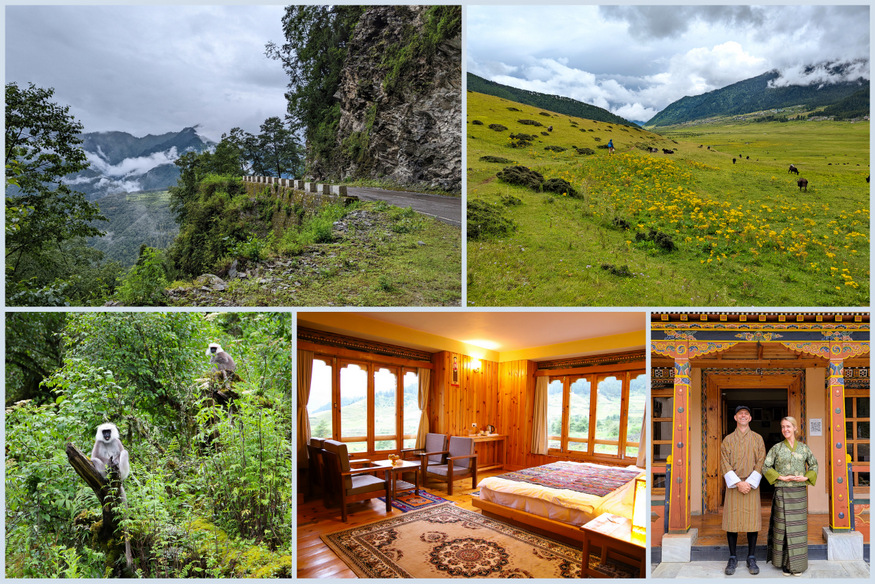 Leaving Punakha, the landscape went from cactus-studded hillsides to birch trees dripping with Spanish moss and gray langur monkeys playing in the trees. Our driver Sonam patiently made countless photo stops for wildlife, gushing waterfalls, and mist-shrouded peaks. Zigzagging up the 10,000-foot pass, we finally descended into the glacier-carved valley of Phobjikha. This wildflower-filled marshland is a protected area for the endangered black-necked cranes, and 13 other globally threatened species. Come October when the majestic cranes make their annual migration from Tibet, people from around the world follow (which explains why there are a ton of luxury hotels in this sleepy village). We stayed at the lovely new Phobjikha Resort, owned by Tim’s sister, to continue growing our Bhutanese family. She gave us a fantastic room overlooking the valley, complete with beautiful textiles, artful lighting, and a wood-burning fireplace. Her team even taught us how to get dressed in traditional clothing so we’d look our Bhutan best at the big festival…
Leaving Punakha, the landscape went from cactus-studded hillsides to birch trees dripping with Spanish moss and gray langur monkeys playing in the trees. Our driver Sonam patiently made countless photo stops for wildlife, gushing waterfalls, and mist-shrouded peaks. Zigzagging up the 10,000-foot pass, we finally descended into the glacier-carved valley of Phobjikha. This wildflower-filled marshland is a protected area for the endangered black-necked cranes, and 13 other globally threatened species. Come October when the majestic cranes make their annual migration from Tibet, people from around the world follow (which explains why there are a ton of luxury hotels in this sleepy village). We stayed at the lovely new Phobjikha Resort, owned by Tim’s sister, to continue growing our Bhutanese family. She gave us a fantastic room overlooking the valley, complete with beautiful textiles, artful lighting, and a wood-burning fireplace. Her team even taught us how to get dressed in traditional clothing so we’d look our Bhutan best at the big festival…
Gangtey Monastery
 Phobjikha Valley houses the biggest private monastery in the country and one of the most impressive. Tim’s brother-in-law is the abbot (pays to know people!), so we scored an invitation for tea with a lama who had recently come back from his 3-year meditation, and front-row entry to the closing ceremonies of this five-day festival. Bhutan is well known for their mask dance festivals and with this beautiful 17th-century, mountain monastery as a backdrop, we couldn’t have asked for a better spot or time to experience it (we were literally the only tourists out of nearly 4,000 people in attendance!). We walked into a room with intense vibrations of drums and chants from people seated hip to hip. We hoped our local garb would help us blend in, but it didn’t matter, all the stares were accompanied with a smile. When people poured out of that space towards the main stage, we hung back and witnessed it turn into the green room for elaborate costume changes and grand entrances in this procession to ward off life’s obstacles. The dances were fascinating to watch, as they moved from the courtyard to a bonfire finale on the cliff. We’ll let the photos speak for themselves and end by saying, you have to witness a Bhutanese mask festival at some point in your life! Watch our new Bhutan travel guide video to see some these incredible dances.
Phobjikha Valley houses the biggest private monastery in the country and one of the most impressive. Tim’s brother-in-law is the abbot (pays to know people!), so we scored an invitation for tea with a lama who had recently come back from his 3-year meditation, and front-row entry to the closing ceremonies of this five-day festival. Bhutan is well known for their mask dance festivals and with this beautiful 17th-century, mountain monastery as a backdrop, we couldn’t have asked for a better spot or time to experience it (we were literally the only tourists out of nearly 4,000 people in attendance!). We walked into a room with intense vibrations of drums and chants from people seated hip to hip. We hoped our local garb would help us blend in, but it didn’t matter, all the stares were accompanied with a smile. When people poured out of that space towards the main stage, we hung back and witnessed it turn into the green room for elaborate costume changes and grand entrances in this procession to ward off life’s obstacles. The dances were fascinating to watch, as they moved from the courtyard to a bonfire finale on the cliff. We’ll let the photos speak for themselves and end by saying, you have to witness a Bhutanese mask festival at some point in your life! Watch our new Bhutan travel guide video to see some these incredible dances.
The Trans-Bhutan Trail
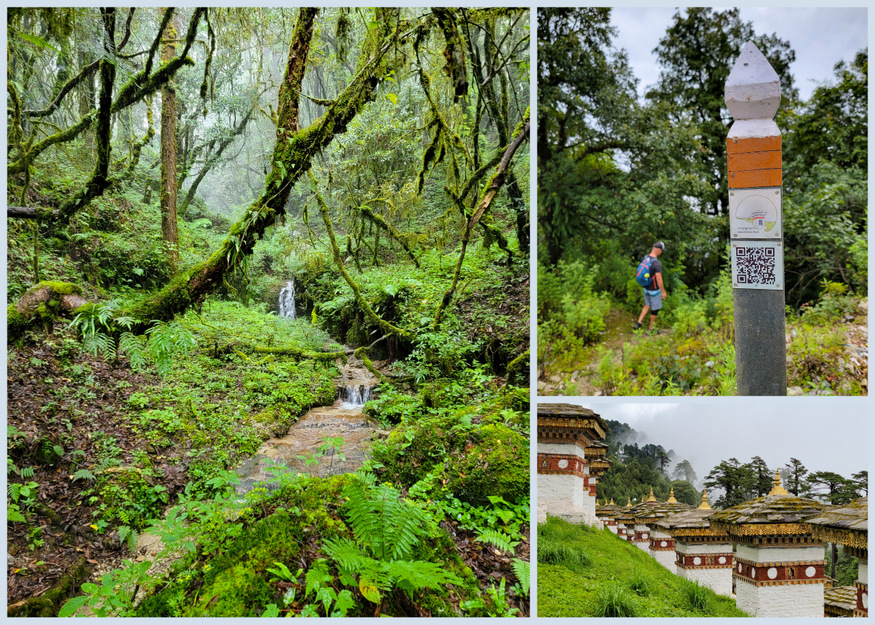 Up until roads were built in the 60s, the Bhutanese relied on a 250-mile footpath that connected the country. Modern times and Mother Nature virtually erased the path, but as of 2022 the restored Trans-Bhutan Trail is open for locals and foreign trekkers alike. We hiked a section of the trail near Dochula Pass, and were impressed by the lush flora and fauna, the botanical signs, historic markers, and handy QR codes along the way. We ended at Dochula’s 108 hand-painted chortens hungry for more trail time. FYI: While the restoration of the trail was led by the Bhutan Canada Foundation with help from the Tourism Council of Bhutan, the De-Suung, and countless volunteers, don’t let the website TransBhutanTrail.com fool you into thinking you need to spend $20,365 to hike it. It is a public trail and can be done for any duration you’d like, so hike at least a few miles and imagine the centuries of footsteps before you.
Up until roads were built in the 60s, the Bhutanese relied on a 250-mile footpath that connected the country. Modern times and Mother Nature virtually erased the path, but as of 2022 the restored Trans-Bhutan Trail is open for locals and foreign trekkers alike. We hiked a section of the trail near Dochula Pass, and were impressed by the lush flora and fauna, the botanical signs, historic markers, and handy QR codes along the way. We ended at Dochula’s 108 hand-painted chortens hungry for more trail time. FYI: While the restoration of the trail was led by the Bhutan Canada Foundation with help from the Tourism Council of Bhutan, the De-Suung, and countless volunteers, don’t let the website TransBhutanTrail.com fool you into thinking you need to spend $20,365 to hike it. It is a public trail and can be done for any duration you’d like, so hike at least a few miles and imagine the centuries of footsteps before you.
Tiger’s Nest Monastery
 If there is one image of Bhutan that brings people to the country, it is Paro Takstang (aka Tiger’s Nest). 17th-century architecture hugging a sheer cliff and overlooking a Himalayan valley is of course photogenic, but it’s also deeply symbolic to Bhutan’s Buddhist history. Legend has it that in the 8th century, Guru Rinpoche flew on the back of a Tigress to defeat the Tiger demon in this cave and subdue the evil spirits across the land. He then meditated there for 3 years, 3 months, and 3 weeks and brought Buddhism and peace to Bhutan. Legends aside, the beauty of this monastery and the pilgrims’ passion for it is something extraordinary. Mike was leading the charge for us to wake up at 4am to catch sunrise and as much as I groaned, I’m glad he made us trek two miles in the dark to see the early-morning mist swirl around the temple with absolutely no one around. As the sun came up, so did the pilgrims trekking the final stretch past the waterfall and up the cliff in their finest clothes. We took off our shoes to enter the temple, feeling the chill beneath our feet. The floors were bare rock and the walls were cut to the angle of the cliff, yet despite this rough-hewn structure, the decoration was masterful. We climbed from room to room, receiving handfuls of holy water to coat our hair, neck, and tongues. Every Bhutanese person there was doing multiple full-body bows to the altar while our heads just spun with the intensity and beauty of this place. After experiencing Tiger’s Nest, most people turn around and head back down, but in reality this is just 1 of 7 temples on this mountain and there is a glamping camp near the top! Climbing 5,867 vertical feet to Bumdrak temple and camp, we trekked under trees dancing with lichen, laundry lines of monk robes, and cliffs that only seemed to get taller. Nine kilometers later, through the rain, we reached Bumdrak Camp serving up cozy beds and hot food and felt like we had reached nirvana.
If there is one image of Bhutan that brings people to the country, it is Paro Takstang (aka Tiger’s Nest). 17th-century architecture hugging a sheer cliff and overlooking a Himalayan valley is of course photogenic, but it’s also deeply symbolic to Bhutan’s Buddhist history. Legend has it that in the 8th century, Guru Rinpoche flew on the back of a Tigress to defeat the Tiger demon in this cave and subdue the evil spirits across the land. He then meditated there for 3 years, 3 months, and 3 weeks and brought Buddhism and peace to Bhutan. Legends aside, the beauty of this monastery and the pilgrims’ passion for it is something extraordinary. Mike was leading the charge for us to wake up at 4am to catch sunrise and as much as I groaned, I’m glad he made us trek two miles in the dark to see the early-morning mist swirl around the temple with absolutely no one around. As the sun came up, so did the pilgrims trekking the final stretch past the waterfall and up the cliff in their finest clothes. We took off our shoes to enter the temple, feeling the chill beneath our feet. The floors were bare rock and the walls were cut to the angle of the cliff, yet despite this rough-hewn structure, the decoration was masterful. We climbed from room to room, receiving handfuls of holy water to coat our hair, neck, and tongues. Every Bhutanese person there was doing multiple full-body bows to the altar while our heads just spun with the intensity and beauty of this place. After experiencing Tiger’s Nest, most people turn around and head back down, but in reality this is just 1 of 7 temples on this mountain and there is a glamping camp near the top! Climbing 5,867 vertical feet to Bumdrak temple and camp, we trekked under trees dancing with lichen, laundry lines of monk robes, and cliffs that only seemed to get taller. Nine kilometers later, through the rain, we reached Bumdrak Camp serving up cozy beds and hot food and felt like we had reached nirvana.
New Bhutan Travel Guide Tip: Ask your guide to show you Dzongdrakha, a much lesser known cliff temple with visual and historical nods to Tiger’s Nest, just outside of Paro town. Guru Rinpoche was said to have leapt to Tiger’s Nest from this cliff, with a tiger footprint in the rock to show for it. Our favorite part of the visit? Getting an impromptu private tour, from the 80-year old temple-keeper.
Paro Valley
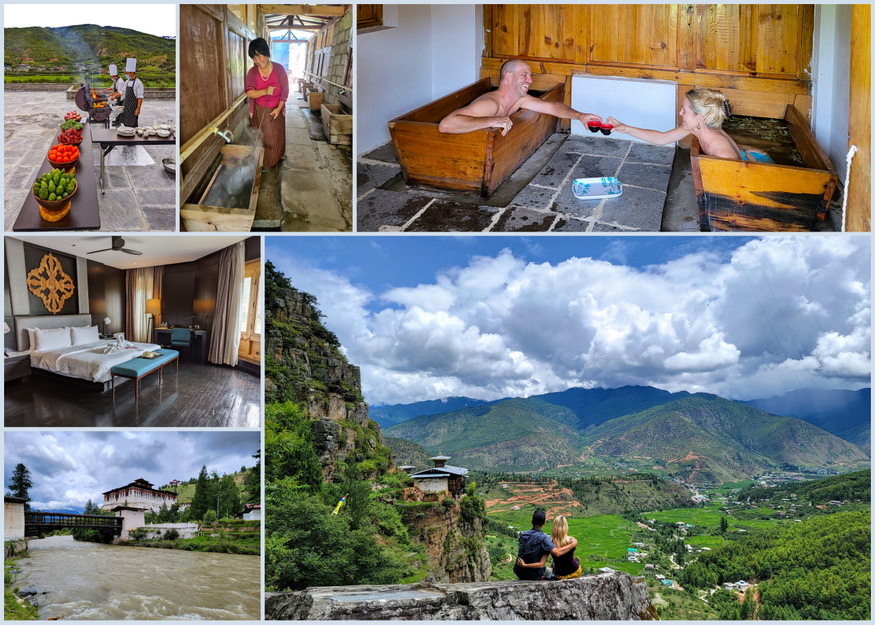 Knowing we could use a little pampering after our overnight trek, Bridge to Bhutan arranged a traditional hot-stone bath (dotsho) and lunch at the historic Tshering Farmhouse. We slipped into the wooden baths with herb-infused water as the innkeeper dropped fire-heated rocks into a chamber at our feet. Taking in the steam, sizzle, and scents melted the miles away and the meal to follow left us totally satisfied. But the goodness kept coming! That night we had a reservation at Le Meridian Paro, one of the finest hotels in the country. Our corner suite was divine, with views over the Paro River and surrounding mountains. We had a barbecue dinner for two on the terrace and a special of bottle of wine to toast the 100 memories we’d made on this trip.
Knowing we could use a little pampering after our overnight trek, Bridge to Bhutan arranged a traditional hot-stone bath (dotsho) and lunch at the historic Tshering Farmhouse. We slipped into the wooden baths with herb-infused water as the innkeeper dropped fire-heated rocks into a chamber at our feet. Taking in the steam, sizzle, and scents melted the miles away and the meal to follow left us totally satisfied. But the goodness kept coming! That night we had a reservation at Le Meridian Paro, one of the finest hotels in the country. Our corner suite was divine, with views over the Paro River and surrounding mountains. We had a barbecue dinner for two on the terrace and a special of bottle of wine to toast the 100 memories we’d made on this trip.
Planning Your Trip: The New Bhutan Travel Guide
 Shangri-La never comes easy, so here are few things to know to make your Bhutan trip a reality.
Shangri-La never comes easy, so here are few things to know to make your Bhutan trip a reality.
Visas: To complete the visa process, you will need a passport (valid for six months); travel insurance (we swear by our Allianz AllTrips Premier Plan); dates of arrival and departure; and payment details. The visa application fee ($40) can be paid by credit card. You can apply for your 90-day visa online or let your guide do the processing (it’s typically included in their service).
COVID-19 Protocols: Vaccination is strongly encouraged but not required. To take precautions, the government is issuing random RT-PCR testing at the airport.
Sustainable Development Fee (SDF): This tourist tax funds the national social programs, infrastructure, and environmental protections. It is currently $200 per day for adults, $100 for kids ages 6 to 12, and free for those 5 or younger. Yes, it’s expensive but well worth it to spend time in this truly unique country, one that’s taking a stand on overtourism and trying to better serve their people and the environment.
Flights: Drukair and Bhutan Airlines fly to Paro, the country’s only international airport. Departures are available from Singapore; Kathmandu, Dhaka, Bangkok, and five Indian cities (New Delhi, Kolkata, Guwahati, Gaya, and Bagdogra). Tickets tend to be cheaper from India, though you’ll need to get India’s tourist visa ($25) for this move. (We flew from New Delhi and used our Indian visa and trans-Atlantic flight as an excuse to extend our trip for three weeks in Kerala and Goa and arguably our favorite continent, Asia!)
Resources: The national tourism website Bhutan.travel offers the most up-to-date information (don’t trust old articles, a lot has changed!) and they encourage visitors to reach out to their in-house “hosts” to field any questions by email (their FAQ page is also super helpful for a wide variety of topics.). As we mentioned, guides are necessary to travel outside of Paro and Thimphu, and to any cultural sites. Do your own research on tour companies but we cannot recommend Bridge to Bhutan highly enough and are so grateful we found them as guides and friends.
Love for Bhutan
 Of the 70 countries we’ve explored on our HoneyTrek, Bhutan is easily one of the most unique and dazzling. We can’t wait to go back someday and hope to see you there! For more videos and photos on our travels through Bhutan watch our Instagram Stories Highlight Reel and this 90-second IG Rreel . We’d love to hear comments and questions, so don’t be shy!
Of the 70 countries we’ve explored on our HoneyTrek, Bhutan is easily one of the most unique and dazzling. We can’t wait to go back someday and hope to see you there! For more videos and photos on our travels through Bhutan watch our Instagram Stories Highlight Reel and this 90-second IG Rreel . We’d love to hear comments and questions, so don’t be shy!
[ad_2]



